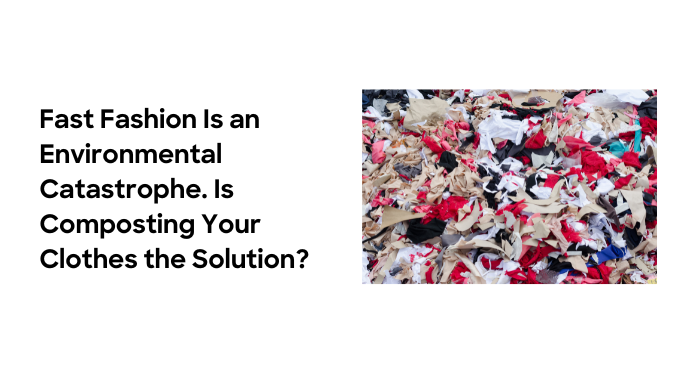The fashion industry accounts for up to 8% of global carbon dioxide emissions, according to the United Nations Environment Programme. That’s more than global shipping and air travel combined.
Most of those clothes — about 84% — end up in landfills or incinerators. In the United States alone, more than 11 million tons of textile waste ended up in landfills in 2018, according to the Environmental Protection Agency’s most recent data.
Is composting your clothes the solution?
Composting refers to the process of recycling organic matter -in most households, composting is the process of turning organic matter, such as food scraps and yard waste like leaves, into fertilizer. Since composting is an aerobic process, it does not result in the production of methane, a strong greenhouse gas that organic materials release when they break down in landfills with insufficient oxygen.
Natalie Patricia, the founder of Harvest & Mill- whose clothes are made entirely from the U.S. sourced organic cotton said, “Organic cotton is a plant grown on a farm just like our food is. And so, it can and should be composted and returned to the soil,”.
Many brands treat their fabric with so-called forever chemicals to make them waterproof or stain- or wrinkle-resistant. However, clothing cannot be made just from natural fabrics such as cotton, silk and wool and be compostable.
“There are a lot of brands out there who say they’re compostable, but they just mean they’re using cotton or linen or hemp. Their dyes, the seams of every piece aren’t [compostable],” said Katherine Quigley, whose company, Sustain, uses all plant-based dyes.
Katherine, in order to make her line fully compostable, she had to work with manufacturers who agreed to use cotton sewing thread. “They all want to use polyester, which just means – unless you’re cutting out every seam – it’s not compostable,” she said.
But even if every last seam is made from organic material, few composting facilities take textile waste. It is difficult to verify the fabric content and they can’t risk contamination, said Paul Foulkes-Arellano, founder of Circuthon, a management consultancy that helps businesses transition to circular economies.
A meaningful difference
Foulkes-Arellano, who is based out of London and has studied textile disposal systems in Europe, said for composting to make a meaningful difference, it would need to be at a large scale, like at the government level — not at a brand level. “Unless a brand guarantees to collect all its own garments it’s wishful thinking,” he said.
Patricia, of Harvest & Mill, said her company is working with the nonprofit Fibershed to test composting conditions with municipal and private facilities in California. If they’re able to get those facilities on board, Patricia said it would allow Harvest & Mill to create a composting “take-back” program.
“[Composting] is one of those big problems that, at least right now, must be solved by fashion brands and waste stream systems and not just left to individual consumers because most individual consumers don’t have their own personal compost bin pile,” said Patricia.
Even if you compost in your backyard, you still need to decide whether you want to take the chance of composting cloth and whether it would benefit your lettuce or flowers.
Adopting universal compost standards for textile waste could be one way to help consumers safely dispose of old clothes, she said, but until then, “I would never recommend someone put it in their backyard compost, especially for amending soil to grow food.”
Foulkes-Arellano said he sees more promise in textile recycling. “I believe in keeping things going around the loop, and we now know cotton can be recycled,” said Foulkes-Arellano.
What’s next?
Of course, the amount of clothing being recycled, composted or, more often, sent to the landfill points to the bigger problem: there’s simply too much of it being produced.
A 2016 World Economic Forum report estimated 150 billion new garments are created each year. The number of clothing items produced each year doubled between 2000 and 2014, according to the consulting firm McKinsey. It’s not just harmful to the environment: production of fast fashion clothing requires cheap, mostly unregulated labor as well. It’s estimated that 98% of fast fashion factory workers don’t make a living wage.
“What we need to do is just get away from this idea that clothing is disposable,” said Katherine Quigley.
“If you look back, even to the first half of the 20th century, wardrobes were a fifth of our size, but they were paying more, and the items lasted much longer.’’
A cotton t-shirt from Sustain costs around $48, which costs twice as much as a similar shirt from GAP. Quigley said she believes new government policies could even the playing field between fast-fashion brands and companies like hers. She said supports higher taxes on high-polluting fast fashion companies or incentives for companies to manufacture domestically.
“One thing that could really help is if the government started making clothing companies responsible for the full life cycle of their clothing,” Quigley said.
“If a piece of polyester clothing actually incorporated the cost of what it takes to recycle or clean up the end-life of that clothing, it would inevitably cost more.” she adds.
When consumers pay $56 for a t-shirt from Stripe & Stare, (among a growing number of clothing brands, marketing biodegradable clothing that they say can be disposed of in a compost bin) they’re paying for carbon offsets, high labor standards and state-of-the-art, biodegradable materials.
In short, we should try to support the idea of buying less yet better.
Also read: How is climate change affecting the Uniform Industry?













